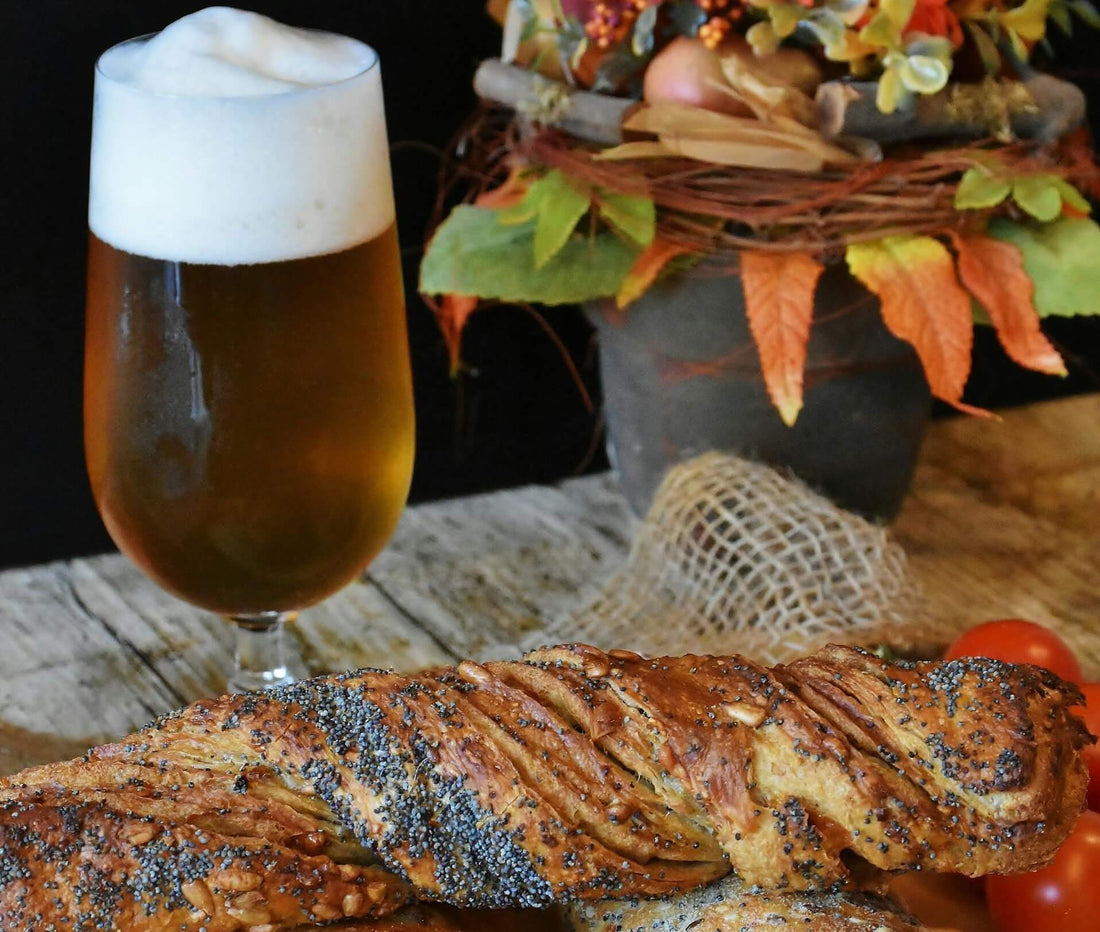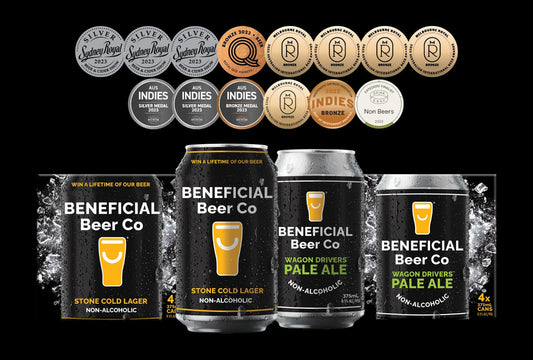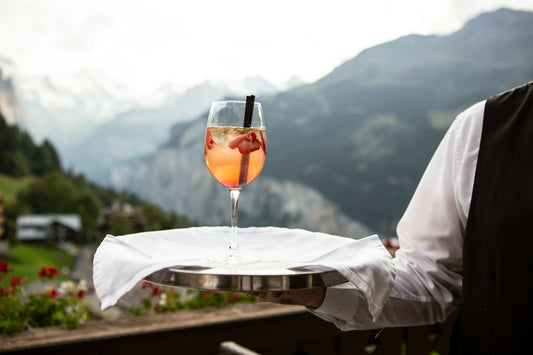When you learn that some everyday foods and drinks contain alcohol, choosing what to chew can be a minefield. Especially if you’re health-conscious or under a dietary law. This revelation is a wake-up call. Below we'll showcase the true alcohol content in our diets; how it impacts the faithful, the zero-gravity connoisseurs, and more.
Perhaps by the end, you'll change your approach to eating and drinking. After all, if a Beneficial Beer has less booze than bread, where do we draw the line?
.
The Truth About Alcohol in Everyday Foods
Fruit
You may already know that fruit contains alcohol, but even the animal kingdom is getting a taste of the action. Drink-flying laws don't apply to the poor English Blackbirds found dead after consuming fermented berries from rowan trees. The high alcohol content in their systems fried navigation, causing mid-air collisions and other fatal injuries. Redwings have also been caught on the fermented berry nip, tumbling out of holly trees.

A study conducted in 2008 by animal physiologists Frank Wiens and Annette Ziztmann found that tiny pentailed treeshrews regularly consumed nectar from the bertam palm, which contains 3.8% alcohol—comparable to some beers.
Closer to home, consider your pantry:
- Matured peeled bananas can have an ethanol concentration of 0.5 g/100 g, while ripe bananas typically contain about 0.4 g/100g (this can equate up to 0.63%)
- Grape and apple juice, other common staples, have been found to have ethanol levels just below 0.1%. But according to the German “Deutsches Lebensmittelbuch” (German Book of Food Standards, Nov 2002), fruit juices can contain up to 0.38% ethanol, equating to about 0.038% BAC.
- Some of the highest concentrations of alcohol are detected in a hog plum (Spondias mombin) at more than 1.5%...

.
Bread
Sourdough has a dark side.
During the fermentation process, sourdough starters can produce alcohol. The liquid that sometimes forms on top is known as "hooch" and can contain a surprising 15-18% alcohol by volume.
That sounds like a lot, but you aren't getting drunk from your toast (probably). When sourdough bread is baked, the majority of this alcohol evaporates. The final baked product typically contains low levels of alcohol under 0.5% by volume.
Now we know all of Sour B's boozy secrets, it's easy to compare it to non-alcoholic beer, which similarly contains 0.5% ABV. The line is getting fuzzy now...
Is eating sourdough or drinking non-alcohol more appropriate at an alcohol-free shindig?
(Some packaged bakery products, like milk rolls and certain American-style burger rolls, have been found to contain alcohol levels as high as 1.5%!)

.
Fermented Foods: Sauerkraut, Kombucha, and Kimchi
Sauerkraut is a tangy addition to sandwiches and spreads, but during its fermentation, the ethanol concentration can reach up to 2 g/kg (around 0.2%).
Kombucha, a popular fermented tea, typically contains up to 0.5% alcohol. However, homemade kombucha can sometimes have higher alcohol levels, ranging from 0.5% to 3% alcohol. As the yeast consumes sugar and produces ethanol in kombucha, factors like fermentation time, temperature, type of yeast used, and sugar content will effect the final %.
Kimchi, a staple in Korean cuisine, is another fermented vegetable dish that contains small amounts of alcohol. The alcohol content in kimchi usually ranges from 0.1% to 1.3%.

.
And a Few More to Take it Home…
- Soy Sauce and Hot Sauce: Both staples in many kitchens, soy sauce can contain up to 2% alcohol by volume, while some hot sauces contain up to 2% too!
- Vanilla Extract: Often used in baking and cooking, vanilla extract can contain up to 35% ABV. Who knew the cake could party too?
- Vinegar: Depending on the type, vinegar can have an alcohol content ranging from 0.3% to 2% ABV.
- Perfumes and Colognes: Although not consumed, these smelly syrups can contain up to 95% alcohol. This high concentration helps in the dispersion of the scent.
.
Can You Drink Non-Alc Beer as a Muslim?
For many Muslims, dietary laws are a fundamental aspect of their faith. Whether non-alcoholic beer is permissible, or halal, is hotly debated.
Some argue that non-alcoholic beer is haram (forbidden) because:
- It is produced by the same companies that make regular alcoholic beers.
- It is not completely free of alcohol, typically containing up to 0.5% ABV.
- Drinking culture is not aligned with Islamic values.
While others believe that it is permissible:
- Many everyday foods, such as bread, contain trace amounts of alcohol due to fermentation.
- If non-alcoholic beer does not intoxicate and contains almost no alcohol, it can be considered permissible.
- Some believe that the primary concern in the Quran is the loss of control and intoxication, which non-alcoholic beer does not cause.
This raises the question: Should people choose their foods based on alcohol content or the food's connection to alcohol?
Ultimately, whether a Muslim can drink non-alcoholic beer depends on their beliefs, interpretations and opinions. Talking to an expert in these fields is essential to make informed decisions.
.
Can an Astronaut Drink Non-Alcoholic Beer?

In 1969, Apollo 11 astronaut Buzz Aldrin drank wine during communion on the Moon. Since then, astronauts and cosmonauts are prohibited from drinking booze. Even the effects of microgravity on drunk-ness aren't well studied...
Interestingly, some space-friendly foods can contain trace amounts of alcohol due to natural fermentation.
- Flavoured drinks like lemonade or orange drink, provided in vacuum-sealed pouches, can contain about 0.02% to 0.09% alcohol by volume (ABV).
- Bread products, including burger rolls, are another source of trace alcohol. When Astronauts made and ate hamburgers on the ISS in 2002, nobody flagged the 0.5% alcohol content typically found in them.
There is no specific mention of non-alcoholic beers being prohibited for astronauts. But there are a couple of issues:
- The lack of gravity prevents bubbles from rising, resulting in "wet burps" and making it impossible for a foamy head to form.
- The SpaceX Rideshare Program charges per kg to send cargo to the into orbit, making a 10kg carton of Beneficial Beer cost a staggering $300,000 USD!
.
Can a Driver Drink Non-Alcoholic Beer?
Like non-alcoholic beers at 0.5% ABV, several other common substances and conditions can also cause false positives in preliminary breathalyser tests:
- Certain foods, such as very ripe fruits and fermented foods
- Mouthwashes containing alcohol
- Breath sprays
- Some medications, like cough syrups
- Lemon, lime, and bitters (LLB) drinks
- Products containing vanilla essence
These false positives usually affect only the preliminary roadside tests. More accurate follow-up tests at a police station can typically distinguish between trace amounts and significant blood alcohol levels.

Can an Olympic Athlete Drink Non-Alcoholic Beer?
If you’re interested in Olympians drinking non-alcoholic beer and winning GOLD , along with some juicy the performance studies into non-alcoholic beer, check out our latest article here.
.
Rethinking Our Relationship with Alcohol
The notion of completely avoiding alcohol is nearly impossible unless one is prepared to skip many delicious and nutritious foods.
Is it ethical to judge non-alcoholic beer differently from other everyday foods that contain the same amount of alcohol? By subtly challenging common social norms, we can drive non-alcoholic beers into more settings.
Besides, non-alcoholic beverages already offer numerous benefits in social settings, and big changes start with small decisions...
.




